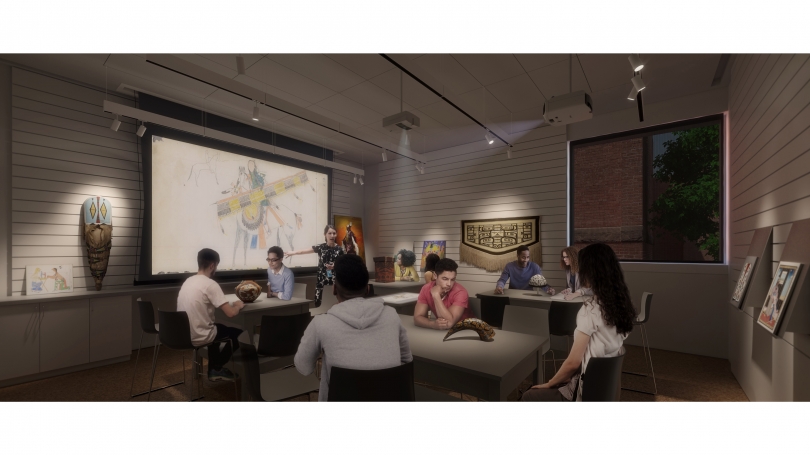Major Gift Will Fund New Center for Object-Based Inquiry
The Hood Museum of Art is known for its behind-the-scenes curricular engagement with its collections for Dartmouth faculty and students, and that engagement will now be at the forefront of the museum's major expansion in the years ahead, thanks to a $10 million gift from an anonymous donor. A new state-of-the-art object-study center that will be the centerpiece of the design for the renovated and expanded museum facility by Tod Williams Billie Tsien Architects. Current plans indicate that the work will begin in spring 2016.
"This gift gets to the heart of what Dartmouth does best: provide undergraduates with unparalleled opportunities for authentic, challenging, active learning experiences," said President Phil Hanlon '77 in a press release announcing the gift to the community. "The Hood Museum of Art is a model teaching museum, and the Museum Learning Center will expand its capacity to transform student lives. We're deeply grateful for this donor's inspired commitment to Dartmouth students and the arts."
The expansion project will provide the museum with an enlarged and updated facility that will allow the Hood to display more of its collection, provide a better visitor experience, and meet the increasing demand among Dartmouth faculty for teaching with original works of art. The expanded museum facility will make space for more of this learning to happen for all of our visitors, since the new permanent collection galleries will be designed as adaptable, flexible, and beautiful spaces. The cutting-edge museum learning center—vital to the Hood's ability to fulfill its teaching mission—is at the core of the Hood's future on the Dartmouth campus. This generous gift makes it possible to teach with objects from the museum's rich array of collections at an unprecedented level.
The learning center will triple the number of the Hood's object-study classrooms. Four years after the museum opened in 1985, it inaugurated teaching in the Bernstein Study-Storage facility, a classroom located within one of the storage areas of the Hood. Operating much like print rooms in other museums, where small classes and individuals study works on paper, the Hood's new study-storage classroom allowed the curator of academic programming and collections curators to work with faculty to incorporate the study of objects from all media, continents, and chronologies into the curriculum. In this sense, it enlarged what many academic museums practiced and was probably the first study-storage room of its kind. The field of academic programming has also grown since that time with significant grants from the Andrew W. Mellon Foundation starting in 1992, which helped to revolutionize the way college and university museums provide undergraduates with firsthand access to collections. The new museum learning center at the Hood Museum of Art will accommodate the extensive and growing curricular demand for object-based teaching and research using the museum's more than 65,000 works of art. It will make the Hood's teaching mission visible to all and give Dartmouth professors greater freedom and flexibility to integrate object-based teaching into their courses.
The new center's three object-study rooms will be equipped with a range of technological enhancements to make them function as "smart" classrooms, and will be able to accommodate a range of class sizes, allowing the museum to meet the needs of faculty, students, and scholars across many disciplines. They will be outfitted to make teaching with the museum's diverse collections a more intellectually rewarding and enjoyable experience. In these spaces, natural light and furniture designed to facilitate close looking and collaborative learning will be integrated with technology to provide support to different approaches to teaching and learning with the same objects, according to academic discipline or curricular goals.
Learning with objects happens through observation, active discussion and debate, research, analysis and ultimately interpretation. The teaching spaces in the new learning center will be designed to put the object at the center of that conversation. The technology in the learning center will provide rich possibilities for new engagement with objects. For example, a Tlingit potlatch box from the Northwest Coast from the collection can be placed in the object-study room, and with a live camera feed and videoconferencing software, students can talk with a tribal elder on the Northwest Coast who is looking at the object along with them in real time. Or students can focus the powerful magnifying properties of a ceiling-mounted camera on a print by Rembrandt and view the projected image on a large screen in such detail that they can follow the pattern of the metal burr thrown up from the artist's etching tools. Also exciting is that we know that new discoveries about objects in the collection will be made by faculty and students as more, and closer, attention is paid to them.
"Student and faculty engagement is at the heart of the Hood's mission as a teaching museum," said Michael Taylor, director, "and the Hood Museum of Art has been nationally and internationally recognized as a leader in the field for nearly three decades. These years of cultivating teaching and learning with objects, as well as our work with students as interns and in non-curricular programs, have prepared the museum for its next phase of development within an expanded facility that will allow us to reach further and deeper into the curriculum and bring student engagement to a new level. We are immensely grateful to our anonymous donors for providing us with the opportunity to take this next step into the future and hope that this transformational gift will inspire others to support the museum's expansion project and teaching mission."



